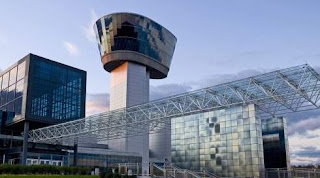The Smithsonian National Air and Space Museum the second most popular of all Smithsonian Museums, got its start on August 12, 1946 when it approved by President Harry S. Truman. It was initially recognized as the National Air Museum, and it was not until the space race was ramping up in the 1960s that the museum was rechristened to its current name. The museum was originally housed in a number of disparate buildings across the city, including the Arts and Industries Building; and it wasn’t until 1976 that a home solely dedicated to the museum was constructed.
 |
| Smithsonian National Air and Space Museum |
Located within the museum is, not surprisingly, a vast collection of some 50,000 objects related to air and spacecraft from a variety of eras. One of the most noted exhibits is the 1903 aircraft that was flown by the Wright Brothers at Kitty Hawk, in what is recognized as the first powered flight. While admiring the plane, you may learn such obscure facts such as that it is composed of wood and fabric held together by steel wire. Noted spacecraft include the Apollo 11 space capsule that flew Michael Collins, Buzz Aldrin and Neil Armstrong to the moon on July 20, 1969. It was on this historic flight that Neil Armstrong would become the first man to walk on the moon. And although it is not a real spaceship, people still flock to the wooden model of the Enterprise that was used in filming the television series Star Trek.
In total there are twenty-galleries for visitation across two floors of exhibits (the third level is left for administrative offices). In addition to the multiple aircrafts that may be admired hanging from the ceiling, a museum store and IMAX theater also exist on the first floor. Another popular attraction is the Albert Einstein Planetarium where visitors may view projected stars and planets across the seventy foot dome.
Visitation of the museum is free and it is open every day of the year less Christmas. Hours are typically from 10:00 am 5:30 pm. Free guided tours are also offered twice daily at 10:30 am and 1 pm. All tours depart from the Welcome Center near the front entrance.
- Website: http://airandspace.si.edu/
- Address: Intersection of 4th Street, SW and Independence Avenue, SW, Washington, DC
- Cost: Free
